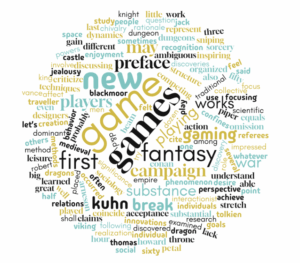Shared Fantasy: Role-Playing Games as Social Worlds by Gary Alan Fine (2002) — Reseña
Shared Fantasy: Los Juegos de Rol como Mundos Sociales de Gary Alan Fine (2002) — Reseña
By: Cristo León
Review published in the Journal of Roleplaying Studies and STEAM, Vol. 2, No. 1 (2023). Last updated on October 08, 2025.
Introduction
This review revisits Gary Alan Fine’s *Shared Fantasy: Role-Playing Games as Social Worlds*, originally published in 1983 and reissued in 2002. Fine’s ethnographic study remains foundational in understanding the social dynamics of tabletop role-playing games such as *Dungeons & Dragons*. By immersing himself in multiple gaming communities, Fine reveals the micro-sociological structures that sustain collaborative storytelling, identity negotiation, and collective imagination in play. His work continues to inform contemporary analyses of participatory culture, gaming communities, and narrative co-construction.
Analysis
Fine’s central argument situates role-playing as a “shared fantasy” in which players co-create semiotic worlds through sustained interaction. His concept of “frames” — social contexts that define meaning and behavior — explains how players oscillate between character, player, and person perspectives. The book’s relevance persists in current RPG scholarship, especially within Role-Playing Game Theory (RPGT), as it offers one of the earliest models linking imagination, performance, and social structure. Fine’s balanced approach between sociology and ludology makes the text an essential reference for researchers examining how storytelling and community intertwine in play.
Review Highlights
- Explains the emergence of TTRPGs as micro-societies with shared norms and expectations.
- Introduces the concept of “frames” to analyze player-character dynamics.
- Demonstrates how fantasy play serves as both escapism and social rehearsal.
- Connects early tabletop play to broader cultural phenomena in narrative and identity formation.
Context and Impact
As one of the first ethnographies of gaming culture, *Shared Fantasy* bridges sociological inquiry and narrative theory. Its influence extends beyond game studies to anthropology, performance studies, and education. Fine’s framework continues to inspire research on community-building, creativity, and collaboration in analog and digital environments. Within the field of RPGT, the text remains a cornerstone for understanding how players collectively construct meaning and maintain coherent fictional worlds.
Cite this Review
León, C. (2023). Shared Fantasy: Role-Playing Games as Social Worlds by Gary Alan Fine (2002) — Reseña.
Journal of Roleplaying Studies and STEAM, 2(1), 78–84.
https://digitalcommons.njit.edu/jrpssteam/vol2/iss1/7/
ISSN: 2992-7803 | Volume: 2 | Issue: 1 | Pages: 78–84
Publisher: Journal of Roleplaying Studies and STEAM
Rights: All rights reserved
Tags: Dungeons & Dragons; Role-playing Games; Juego de Rol (JdR); Fantasy Role-Playing Games; Social Worlds; TTRPG; RPGT; Narrative & Games
Interested in Exploring or Collaborating?
Are you researching the sociology of play, narrative structures, or RPG theory?
Share this post, or cite the article to extend the discussion on the social dimensions of role-playing games.
Versión en Español
Shared Fantasy: Los Juegos de Rol como Mundos Sociales de Gary Alan Fine (2002) — Reseña
Entrada de blog sobre la reseña publicada en el Journal of Roleplaying Studies and STEAM, Vol. 2, No. 1 (2023).
Introducción
Esta reseña revisita *Shared Fantasy: Role-Playing Games as Social Worlds*, el estudio clásico de Gary Alan Fine, originalmente publicado en 1983 y reeditado en 2002. Fine ofrece un análisis etnográfico pionero sobre la cultura de los juegos de rol de mesa como *Dungeons & Dragons*. A través de la observación participante, describe cómo los jugadores crean mundos compartidos, negocian identidades y mantienen comunidades de juego colaborativas. Su trabajo sigue siendo fundamental para comprender la interacción social y la narrativa en el juego.
Análisis
El argumento central de Fine define el rol como una “fantasía compartida” donde los jugadores co-construyen mundos semióticos mediante interacción constante. Su noción de “marcos” explica cómo las personas alternan entre perspectivas de personaje, jugador y persona. Este marco continúa influyendo en la teoría del juego de rol (RPGT) al conectar imaginación, actuación y estructura social.
Aspectos Destacados
- Define los juegos de rol como micro-sociedades con normas compartidas.
- Introduce el concepto de “marco” para estudiar la relación jugador-personaje.
- Interpreta el juego de fantasía como escapismo y práctica social.
- Vincula el juego de rol con fenómenos narrativos y culturales más amplios.
Cita la reseña
León, C. (2023). Shared Fantasy: Role-Playing Games as Social Worlds by Gary Alan Fine (2002) — Reseña.
Journal of Roleplaying Studies and STEAM, 2(1), 78–84.
https://digitalcommons.njit.edu/jrpssteam/vol2/iss1/7/
Podcast
🎧 Escucha el podcast (duración: [X:XX] minutos)

